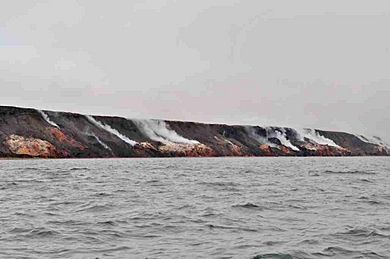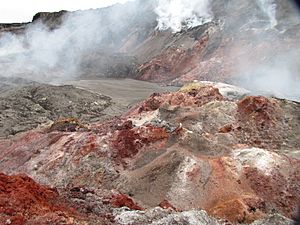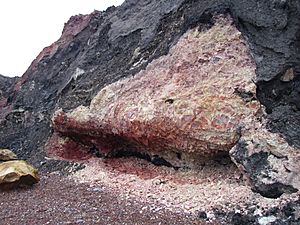Smoking Hills facts for kids
The Smoking Hills are a special place on the east coast of Cape Bathurst in Canada's Northwest Territories. They are right next to the cold Arctic Ocean and some small lakes. These hills got their name from explorer John Franklin. He was the first European to see them way back in 1826. What makes them special is that they have layers of rock called oil shale. These rocks contain natural fuels, and they have been burning non-stop for hundreds of years!
Contents
Why the Hills Are Smoking
The fires at the Smoking Hills start on their own. This happens because of a type of soft coal called lignite found there. This lignite has a lot of sulfur in it. When it gets warm enough, it can catch fire by itself. This process is called autoignition. The constant smoke clouds rising from these fires are why the area is called the Smoking Hills.
Over a long time, the smoke has changed the area. The smoke contains a gas called sulfur dioxide. This gas makes the small ponds in the area very acidic. These ponds are usually less than 1 hectare (about 2.5 acres) in size and less than 1 meter (about 3 feet) deep. Their water can become as acidic as lemon juice or even stronger.
Acidic Ponds and Their Life
Because the ponds are so acidic, they have high levels of metals. These metals include aluminum, iron, zinc, nickel, manganese, and cadmium. The soil and mud around the ponds have also changed due to these chemicals.
The plants and animals living in these acidic ponds are special. They are types that can survive in very acidic places all over the world. This is different from the usual Arctic plants and animals found in other nearby ponds that are not acidic. Even though the soil in the region has a lot of limestone, which usually helps balance acids, it can no longer stop the ponds from becoming acidic.
Changing Cliffs
The coastline of the Smoking Hills is always wearing away. This process, called weathering, keeps showing new layers of minerals from the mud below. These new minerals often look red because they contain a lot of iron.
Nearby Community
The closest community to the Smoking Hills is Paulatuk. It is about 105 kilometers (65 miles) to the east. The name "Paulatuk" comes from the traditional spelling "Paulatuuq." This means "place of coal," which recognizes the coal found in the area.
See also
 In Spanish: Smoking Hills para niños
In Spanish: Smoking Hills para niños




